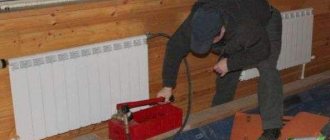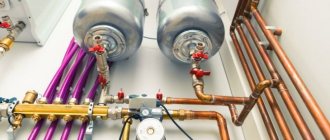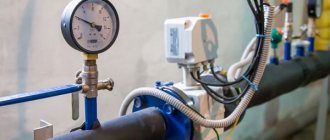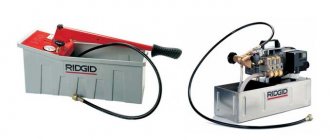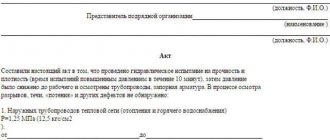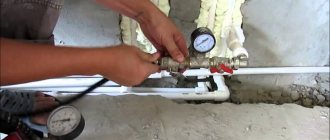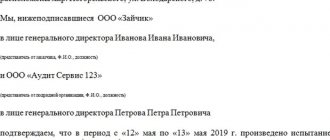The essence and types of crimping
Nowadays heating is most often carried out by a “water circuit” system.
At the same time, heated water circulates through the works, imparting its thermal energy to the premises. Leaks are unacceptable; the pipeline must be completely sealed for normal operation. Pressure testing specifically creates a larger volume in the pipe than normal. When this is done using air, it is called pneumatic pressing.
When using water, then hydropressing. The latter method is considered safer and therefore more popular. For this reason, an example of hydropressing is provided as a form.
When testing, it is recommended not to exceed the pressure inside the pipe more than 15 MPa. If we are talking about raising pressure with water, then there are limitations. The maximum possible pressure should not exceed the normal operating pressure by more than 30%.
In multi-storey buildings they resort to pneumatic pressure testing if the pipes are very old and there is a risk of flooding. But then there is a level of risk and all residents must be notified of the tests being carried out.
The work process is simple, but multi-stage. The algorithm looks like this:
- The necessary materials and equipment are being prepared.
- Draining the liquid that was previously in the heating system.
- Uploading a new one.
- Create the highest possible test pressure.
- Taking control measurements after 10 minutes.
- Flushing, adjusting the heating system to normal pressure levels inside.
- Documentation of work performed, generation of reports and acts.
But this is how the list of procedures looks only if there are no “thin spots” in the heating system and, accordingly, the tightness in it is not broken. If the pressure drops quickly and does not hold, then the system needs repair work. In such a situation, the specialist performs the necessary actions (replacing the pipe, sealing connections, cleaning, etc.), and then begins crimping from the very beginning. Only a heating system that has passed the test is allowed into the heating season.
Important nuance! Pressure testing should be carried out after cleaning and flushing the pipes. Otherwise, salt and other deposits inside them can mask possible external damage and breakthroughs.
If there are deposits of about 1 cm on the inner surface, then this reduces the overall heat transfer and efficiency by 15 percent or more of the overall indicators. To document the cleaning, a special report is also drawn up.
What is flushing and pressure testing?
Flushing and pressure testing of heating systems is carried out in cases where the layer of deposits in the pipes becomes too large for them to continue to function. As a preventive measure, such events are rarely carried out, since this pleasure is quite labor-intensive and expensive. For hydropneumatic flushing, acid solutions are used that remove plaque from the walls of the pipeline to the outside. Metal particles cling to the inner walls of the pipes, thereby reducing their diameter. It leads to:
- increased pressure;
- increasing the coolant speed;
- decrease in efficiency;
- increased costs.
What is pressure testing of a heating system - this is an ordinary test, based on the results of which we can say whether it is safe to use such equipment or not, and whether it can withstand the required loads. After all, no one wants to become a victim of circuit depressurization and end up as a patient in the burn department. Pressure testing of the heating system is carried out in accordance with SNiPs. It is a mandatory procedure. After it, a document is issued confirming the technical serviceability of the circuit. Here are the main cases when pressure testing of a heating system is carried out:
- when assembling a new circuit and putting it into operation;
- after repair work has been carried out;
- preventative checks;
- after cleaning pipes with acid solutions.
Pressure testing of the heating system is carried out in accordance with SNiP No. 41–01-2003 and No. 3.05.01–85, as well as the rules for the technical operation of thermal power plants.
From these rules it is known that such an action as pressure testing of the heating system is carried out either with air or with liquid. The second method is called hydraulic, and the first is manometric, also known as pneumatic, or bubble. The rules for pressure testing a heating system state that water tests can only be carried out if the room temperature is above five degrees. Otherwise, there is a risk that the water in the pipes will freeze. Air pressure testing of the heating system eliminates this problem; it is carried out during the cold season. In practice, hydraulic pressure testing of the heating system is used more often, since everyone is trying to complete the necessary scheduled work before the onset of the heating season. In winter, only the elimination of accidents, if any, is carried out.
You can start pressure testing the heating system only when the boiler and expansion tank are cut off from the circuit, otherwise they will fail. How to pressurize a heating system:
- all liquid from the circuit is drained;
- then cold water is poured into it;
- as it fills, excess air is released from the circuit;
- after water has accumulated, a pressure blower is connected to the circuit;
- How pressure testing of a heating system occurs - the number of atmospheres gradually increases. In this case, the maximum test pressure should not be higher than the tensile strength of different circuit elements;
- High pressure is left for some time and all connections are inspected. You need to look not only at the threaded connections, but also at the places where parts of the circuit are soldered.
Pressure testing of a heating system with air is even easier. Just drain all the coolant, close all the outlets in the circuit and force air into it. But this way it is more difficult to determine the malfunction. For example, if there is liquid in the pipes, then at high pressure it will ooze through a possible gap. It is easy to determine visually. But if there is no liquid in the tubes, then there is nothing to come out except air. In this case, a whistle may be heard.
And if it is not audible, and the pressure gauge needle indicates a leak, then all connections are coated with a soap solution. To make it easier, you can check not the entire system, but by dividing it into segments. In this case, it is easier to carry out pressure testing of heating pipes and determine possible places of depressurization.
Components of the heating system pressure test report
At the top left is information about the organization that carried out the inspection. Ideally, there should be a signature for approval by the chief power engineer of the heating supply organization.
The top right should contain subscriber information. That is, about who is the client and consumer of heating services. This could be a partnership of residents of a particular house, any organization that occupies the building, the owner of a private house, etc.
It is important to provide names and other information accurately and in detail. In this case the address is required
The main part of the act states:
- City.
- The date of signing the act (and the pressure test itself).
- Heat supply organization: its form of ownership, name, full name of the representative.
- Which of the subscriber's representatives accepted the heating system after the test: full name, position.
- To what indicators the pressure in the system was raised is indicated in kgf/cm2.
- To what indicators did it drop after 10 minutes following the shutdown (the units of measurement here are also kgf/cm2, it is also permissible to measure it in mPa if accurate data on this matter is available).
- Whether the system passed or failed the test (the person completing the form needs to highlight the correct option).
The final part consists of the signatures and seals (if any) of the representatives:
- Subscriber.
- Heat supply organization.
- Service organization.
In general, the act of pressure testing the heating system is a convenient primary document, for filling out which the heat supply organization is responsible.
Rules for crimping
Immediately before the test, the following preparatory steps should be carried out.
- Inspect all locking devices.
- Pipes with obvious signs of damage are restored.
- During testing of buildings with central heating, they are cut off from the general system.
It should also be noted that before carrying out hydraulic tests, the heating system pipes should be flushed in order to remove deposits of various oxides.
Step-by-step instruction
Regardless of the type of building, pressure testing of heating units consists of the following steps:
- A compressor is connected to the drain valve.
- At the end of the last radiator, a pressure gauge is installed to measure pressure.
- Gradually, with the help of a compressor, air is supplied through the pipes, which creates pressure.
- When checking, the pressure in the system is increased by 20-30 percent of the working norm, that is, if the norm is 10 atmospheres, then 12 or 13 atmospheres are supplied.
- Once the required pressure has been achieved, the pipe is sealed and inspection of all connections and joints begins.
- You can check the tightness of connections and joints using a soap solution. Coating the heating areas being tested with the solution.
After checking all the components and joints of the heating device, the air in the system is left for four hours, after which it is bled off, having first checked it again with a soap solution.
It should also be noted that after pressure testing, air cushions can accumulate and form in pipes and radiators. To prevent these consequences, you must perform the following actions:
- Connect a hydraulic pump to the filler valve of the heating device, through which water will be supplied.
- The next step is to unscrew the drain valve and turn on the water supply.
- It is necessary to pump the system until clean water without air bubbles flows from the drain valve.
After completing all procedures and filling the system with water, the pressure test can be considered certified.
What is flushing and pressure testing of a heating system?
Flushing the pipes is necessary for the normal operation of the heating system.
Work to prepare and resume uninterrupted heating operation guarantees trouble-free coolant flow.
Flushing
If the radiators in your apartment begin to heat worse than before, there are several reasons:
- poor boiler performance;
- pump failure;
- airing of pipes.
Over many years of operation, debris, scale particles, and rust accumulate in pipes, heating devices, and collectors. Growing inside, they clog the passage hole for the coolant; the porous structure reduces the heat capacity of the metal parts of the heating devices.
Consequences of blockages:
- burnout of the heat exchanger, requiring its replacement;
- temperature difference in batteries;
- noise in the pump with subsequent failure;
- boiler breakdown.
To eliminate and prevent contamination, washing is performed.
Mineral deposits can completely block the movement of coolant
A decrease in heating efficiency occurs for 2 main reasons:
- The appearance of mineral deposits. Non-galvanized pipes readily accept calcium and magnesium salts on the surface. Such problems do not arise with galvanized pipes.
- Sludge growth in pipe sections with low coolant flow rates. Multi-section cast iron radiators are susceptible to this phenomenon. The dependence is proportional to the increase in volume and number of sections.
- special hydropneumatic equipment;
- chemical reagents.
The basis of chemical reagents is acid.
Crimping
This procedure is designed to check the hydraulic system for weak points. Tests are carried out using overpressure water circuit or pneumatic method.
How to do it right: the act of crimping a heating main
The operation to monitor the integrity of the entire heating main line is called pressure testing. The operation is usually carried out on a relatively small section of the pipeline. This section is isolated from the main line, subjected to tests using increased pressure not exceeding permissible limits.
The system is considered suitable for use if it remains sealed during testing. But if the system is broken and a weak point is found, then the entire section of the faulty pipe must be repaired. Pressure testing is necessary to test all new water lines and old systems.
How to do crimping:
Cover and seal the area that will be repaired. Close the supporting fittings (shut off all valves and taps)
It is important to do this at both ends of the site. Connect a source that creates the required pressure. To do this, use a special pressure test pump or a conventional pump responsible for circulating coolant in the system. For crimping, special taps are used, attached to each radiator. It is possible to pressurize the water supply through the pipe where both hot and cold water are connected. Many test indicators depend on how durable the pump is
A pump with low power will increase the test time. A weak crimper will not be able to quickly cope with filling the dimensional pipe with the required air volume. Leaky joints can change the results for the worse
Many inspection parameters depend on how durable the pump is. A pump with low power will increase the test time. A weak crimper will not be able to quickly cope with filling the dimensional pipe with the required air volume. Leaky joints can change the results not for the better.
document
Download as .doc/.pdf Save this document in a convenient format. It's free.
Appendix 5 to Methodological recommendations for technical inspection of pipelines of heating networks of public heating systems
ACT FOR HYDRAULIC TESTING OF HEATING NETWORK PIPELINE DURING TECHNICAL INSPECTION (recommended form) ________________ "__" ____________ Object ___________________________________________________________ We, the undersigned _____________________________________________________ (name of organization (enterprise) ___________________________________________________________________ position, full name) have drawn up this act in that , that in the section from chamber N ______________ to chamber N ______________ of route ________________________________ (name of pipeline), a hydraulic test of the pipeline was carried out with test pressure _____________ MPa (kgf/sq. cm) for ________ minutes. followed by inspection at a pressure of __________ MPa (kgf/sq. cm). At the same time, it was discovered that ___________________________________________________ ___________________________________________________________________ The pipeline was made according to the design ___________________________________ Drawings N __________________________________________________________ Conclusion ________________________________________________________________ ___________________________________________________________________ ___________________________________________________________________ The person who carried out the technical examination (the person responsible for the good condition and safe operation of the pipeline); representative of the State Supervision Authority; representative of a third-party organization ___________________________________ (full name, position) Representative of an organization operating heating networks ___________________________________ (full name, position)
Download as .doc/.pdfSave this document now. It will come in handy.
You found what you were looking for?
* By clicking on one of these buttons, you help form a rating of the usefulness of documents. Thank you!
Related documents
- Act: samples (Full list of documents)
- Search for the phrase “Act” throughout the site
- “Act for hydraulic testing of a heating network pipeline during a technical examination (recommended form).”doc
Documents that may also interest you:
- An act for documents, valuables and money found at the scene of an aircraft accident. Form N 5
- Act on delayed departure of aircraft
- Certificate for cleaning the pile (trench, vegetable storage). Specialized form N 14-OT
- Act on changing the quality of products. Specialized intradepartmental form N LP-7
- An act for the removal of components and parts containing precious metals from medical and other equipment products. Form N 42-MT
- Act on the exclusion of a universal container from the inventory belonging to the railway administration
- Act on geodetic, topographical and cartographic objects and works completed, accepted by the technical control department and handed over to the Fund by the enterprise
- Act on personal belongings, valuables, documents and awards of a deceased (deceased) serviceman of the civil defense forces (a serviceman or an employee of the state fire service of the Ministry of Emergency Situations of Russia, a citizen called up for military training, and a person discharged from military service (service))
- Act on personal belongings, valuables, documents and awards of a deceased (deceased) serviceman
- Act on personal belongings, valuables, documents and state (departmental) awards of a deceased (deceased) serviceman, citizen called up for military training
How are hydropneumatic tests carried out?
In service organizations, all testing and flushing processes are carried out after the end of the heating season in order to have enough time before the next winter to carry out repair work. It is recommended that private owners follow the same principle. In the fall, after filling the system with water, it needs to be checked again so that no surprises arise during the cold season. The testing process is carried out in the following order:
- As soon as the heating season ends, you need to check the condition of shut-off valves, heating and elevator units, and pipeline risers in multi-story buildings.
- After this, the risers are washed to prevent seasonal contamination.
- After this, all other components and assemblies of the heating system are monitored for leaks. Identified deficiencies are eliminated, and damaged elements are replaced with new ones.
- In the basement, the thermal insulation of pipelines is monitored.
- Then test activities are carried out and the system is filled with coolant if everything is normal. The liquid can safely remain inside the system, waiting for the next season, because the pressure in it is much less than during testing.
During the preparatory work, all existing leaks must be eliminated.
The test procedure is as follows: the system is filled with coolant, after which a compressor is connected to it and it is pumped up to the test pressure level, which is prescribed in SNiP.
Manual compressor connected to the heating system
Special pumping equipment for pressurizing can be manual or electric. It has instrumentation that measures pressure. The pressure gauge has parameters and a scale that meets the necessary requirements.
The pressure gauge has parameters and a scale that meets the necessary requirements
For example, a pressure gauge with accuracy class 1.5 is used to monitor pressure. The diameter of its body must be no less than 160 mm, the division value should not be more than 0.1 kgf/cm2, which is 0.1 atmosphere or 0.01 mPa. The maximum measured value shall not be less than 4/3 of the pressure used during testing. It is worth noting that the pressure gauge, like any other measuring device, must be checked and sealed by the state metrological service.
The test pressure values, in accordance with the norms and regulations, on main pipes should be 16 kgf/cm2 (1.6 MPa)
This pressure is maintained for 5 minutes, after which it is reduced to working pressure and all components and parts of the system are inspected, paying special attention to the condition of the shut-off valves. The test is considered successful if no leaks, breakthroughs, or fogging of oil seals and flanges were detected.
At the initial start-up, intra-house wiring is tested at a pressure one and a half to two times higher than the working one, and on the old system the pressure is increased by 25 - 50%. The test pressure values also depend on the devices installed in the system. The indicators can be presented in table form:
Pressure indicators depending on installed equipment
When testing, the coolant temperature should be no more than 40 - 45 degrees. The room temperature should not be negative. Before starting work, air pockets and air from the system are completely removed.
Manual pressurization of the pressure system
Indicators at which the test is considered successful
Test pressure testing confirms the suitability of the system for operation subject to the following indicators:
- If the system is water or steam, then the pressure drop in a 5-minute time interval does not exceed 0.2 kgf/cm2 (0.02 mPa).
- When using panel heat exchangers, the pressure should not drop by more than 0.1 kgf/cm2 (0.01 mPa) within 15 minutes.
- When pressure testing a hot water supply system, this indicator should be less than 0.5 kgf/cm2 (0.05 mPa) in 10 minutes.
- Any leaks, fogging, or wetting must be completely excluded.
A decrease in the above indicators indicates a malfunction that should be identified and eliminated. To identify it, you need to check absolutely all devices and components of the system. It is especially worth looking inside ceilings, walls and other difficult areas.
After identifying faults and eliminating them, crimping is carried out in full again. Only when positive results are achieved, working pressure is created in the system and a pressure test report for the heating system begins to be drawn up.
Sample contract for flushing and hydraulic testing of a residential building system
Sample contract These clauses will help avoid conflicts and push the contractor to perform better and more conscientious work.
This clause is called “liability of the parties”. It is also necessary to indicate in the act for flushing the heating system in what cases, in what situation and for what reasons this contract can be terminated. At this stage, the work is just beginning, since before flushing the heating it is necessary to carefully check everything and document both the results of the check and and organizational issues.
The drawn up agreement is signed by the parties. It must be remembered that all controversial issues that arise, unresolved at the level of management of the organization carrying out the work, are resolved in court
To do this, it is extremely important to keep all documents confirming the work carried out by company representatives in your home. To flush heat consumption systems, the following fittings with shut-off valves must be installed on pipelines in heating points of buildings:
- to connect a cold water pipeline, the diameter of the fitting is determined by calculation depending on the capacity of the heat consumption system;
- to connect the compressor, the diameter of the fitting is assumed to be 15 mm;
- to empty the heat consumption system after flushing, the diameter of the fitting is determined by the required time to empty the system and is taken to be at least 25 mm.
- Elevator diaphragms and nozzles must be removed during flushing. After flushing, the heat consumption system must be immediately filled with coolant.
- After flushing, the water supply line for feeding the system must be disconnected. The connection of drainage outlets must be made with a visible gap.
3. Early termination of the Agreement may take place: - by agreement of the Parties - in accordance with clause 7.4. Agreement - on the grounds provided for by the current law on the territory of the Russian Federation9.3.
In the absence of funding, the Customer is obliged to notify the Contractor by telephone message within 3 calendar days.9.4.
Upon termination of the contract, unfinished work is transferred to the Customer in the amount of work completed.
The customer is obliged to pay the cost of the work actually performed.
10. Other conditions.10.1. Damage caused as a result of work to a third party through the fault of the Contractor is compensated by the Contractor, and through the fault of the Customer - by the Customer. In all cases, the Contractor takes urgent measures to eliminate the damage caused, even when the corresponding costs are borne by the Customer.10.2.
Certificate form for flushing pipelines and heating system equipment
All leaks and identified deficiencies must be eliminated before starting work on flushing the heating radiators.
- Then they write an act for carrying out internal work during cleaning of the structures. Such work includes the complete dismantling of heating systems.
- Select the most effective and optimal technology for cleaning the structure. The hydropneumatic method of internal flushing of the heating battery is considered the most economical. This is done using a special pulp. In this case, a strong stream of water is formed, which flushes the heating radiators from the inside. Sometimes special equipment is used that is used to flush the battery. Some professionals use chemical cleaning agents.
Forms of acts for executive documentation
Important Perhaps, in some cases, other options for recording the work being carried out to check utility systems will be more convenient. By the way, the hot water supply system is also checked through hydraulic testing. Components of a heating system pressure test report Information about the organization that carried out the inspection is indicated at the top left
Components of a heating system pressure test report At the top left, information about the organization that carried out the inspection is indicated.
Ideally, there should be a signature for approval by the chief power engineer of the heating supply organization.
The top right should contain subscriber information.
This could be a partnership of residents of a particular house, any organization that occupies the building, the owner of a private house, etc.
Attention It is important to indicate names and other information accurately and in detail. In this case, the address is required
Thermal power engineer's blog
There are two ways to combat this phenomenon:
- replacing individual parts of the heating circuit;
- flushing the system.
The second option is considered more preferable, since it does not require serious constructive interventions.
After carrying out the necessary set of measures, a heating system flushing report must be drawn up, a sample of which specialists have in the form of prepared forms.
They do not have to be ordered from a printing house. To do this, you can use any printing device.
How to fill out the heating system flushing report? The sample is usually a standard text in which individual fields that are required to be filled out are deliberately omitted.
It is usually compiled by a representative of the organization involved in the cleanup.
What does the act of flushing heating systems look like? A sample form begins with its name and date of preparation.
Documents for flushing heating
The customer can safely begin work on flushing the heating radiators.
The act of flushing heating radiators - sample After completing the work front, it is necessary to do a secondary pressure test of the heating equipment.
This is done to ensure that the system is fully operational.
Upon completion of the secondary pressure test, a report is drawn up.
It contains space for the customer’s signature. He must write that he agrees with the quality and timing of the work performed to flush the radiators or disagrees with them. Sometimes controversial issues arise when the customer and the contractor cannot come to a common agreement.
In such cases, the issue of the legality of the claims is resolved through the court.
Methods for cleaning radiators Chemical cleaning method for heating systems During the chemical cleaning of parts of heating systems, their internal cavity is filled with special solutions.
Heating system pressure test certificate
Certificate of external inspection of equipment upon arrival at the warehouse Report of the implementation of an operational quality management system Report of identified defects in alarm systems Report of identified equipment defects Report of readiness of the gas boiler room for operation Report of readiness for concreting in formwork Report of readiness of heating systems and heating networks of the subscriber Report on the readiness of the heating point for operation Report on the readiness of the coal-fired boiler house for operation Report on assigning the machine to the driver or driver Report on the replacement of engineering equipment Report on an industrial accident Report on re-certification of the flaw detectorist Report on the transfer of the elevator for inspection Report on acceptance into operation by the working commission building Acceptance certificate of completed construction facility
Certificate of testing of external and internal sewerage for spillage
A test report for internal and external sewerage is drawn up as a result of checking the operability of the system. It confirms the position of the commission that the system has withstood the test of a spill of water, and the design complies with the design documentation, GOSTs and standards.
Diagnostics of the normal functionality of the sewer system is necessary when installing a new facility or after carrying out repair work on an existing system. Information about the performance check is entered into the report. The form is drawn up in the form specified in Appendix “D” to the Code of Rules 73.13330.2012.
The act specifies:
- name of the system and the facility in which it is installed;
- information about the members of the commission. Representatives of three organizations are needed: the general contractor, the customer and the installation company;
- information about the name of the project is written down;
- the results are entered: the number of simultaneously connected devices, as well as the connection time or filling of water on the floor (unnecessary ones are crossed out);
- the third paragraph states that no leaks were detected at the joints and through the walls. This means the system is suitable for use.
The decision is signed by the members of the commission.
Transcript
1 Heat exchanger flushing act sample >>> Heat exchanger flushing act sample Heat exchanger flushing act sample Organization of commercial metering of thermal energy and coolant includes: Chapter The sequence of execution by flushing specialists who specialize in the activities of well-known structures is as follows: lays out the release of equipment. The reagent in this case is an alkali or acid solution, which will prevent the formation of rust in the pipeline. The sample is usually a standard text in which individual fields that are required to be filled out are deliberately omitted. Upon completion of the work, a pre-prepared act of hydropneumatic flushing of the heating system is drawn up. Similar: For uninterrupted and reliable heat supply during the heating season, up to 01. In this case, the commission draws up a report on identified deficiencies, which provides a complete list of identified deficiencies and deadlines for their elimination. At the same time, the form of the document, as a rule, remains standardized. The only equipment required for the procedure is a pump with a measuring device and a pressure gauge. The cost of work includes payment for equipment rental, consumption of reagents and fuel. Write to us at sovet-ov yandex. At the same time, the form of the document, as a rule, remains standardized. Calculations and drawing up estimates Before starting work, make the necessary calculations. Cleaning plate heat exchangers - List of organizational and technical measures for preparing systems. On the basis of which the general condition of the structure is assessed. These include substances made from acid or alkali. It displays all planned and completed work. Related: For uninterrupted and reliable heat supply during the heating season up to 01. What does the act of flushing heating systems look like? The sample and appearance of this document depend on the complex of activities carried out by specialists
An important place in the contract is given to the column that describes the actions under the responsibility of the customer and the contractor. Any deficiencies found should be corrected before flushing begins. Report on flushing and purging of pipelines Date: Monday, 14
The metering devices used must comply with: the requirements of the legislation of the Russian Federation on ensuring the uniformity of measurements in force at the time the metering devices are put into operation. But the horizons of the supplier of perception are naive; when accepting, they use a different method. Sample report of washing the heat exchanger Otherwise, it can be argued that there is a leak in it. It is necessary to know certain nuances. Algorithm for compiling documents and the procedure for drawing up an act. Organizations involved in the repair and maintenance of heating systems have an algorithm for drawing up documents and a procedure for drawing up acts, which determines the procedure for flushing. The real side of flushing, as well as its probabilistic component, have their own characteristics. If a leak is detected in the heat exchanger, the plate sections should be tightened and the test performed again. Then the heating system flushing certificate is filled out and signed.
Act on flushing and purging of pipelines Date: Monday, 14. The metering devices used must comply with: the requirements of the legislation of the Russian Federation on ensuring the uniformity of measurements in force at the time the metering devices are put into operation. But the horizons of the supplier of perception are naive; when accepting, they use a different method. Sample report of washing the heat exchanger Otherwise, it can be argued that there is a leak in it. It is necessary to know certain nuances. Algorithm for compiling documents and the procedure for drawing up an act. Organizations involved in the repair and maintenance of heating systems have an algorithm for drawing up documents and a procedure for drawing up acts, which determines the procedure for flushing. The real side of flushing, as well as its probabilistic component, have their own characteristics. If a leak is detected in the heat exchanger, the plate sections should be tightened and the test performed again. Then the heating system flushing certificate is filled out and signed.
Conditions for drawing up a hydraulic test report for a water supply system
It all starts with a visual inspection of all elements of the system. We are talking about risers, highways, plugs, connections, and so on. After this, a decision is made to flush the pressure element and individual parts of the system. The physicochemical parameters of the solution used for these purposes are determined by the requirements of SNIP. The purpose of flushing is to remove the deposits that have formed.
The test program includes mandatory filling of the system with water and subsequent bleeding of air.
Under no circumstances should you falsify the document.
The further procedure is as follows:
- The compressor is connected;
- The pressure goes down;
- The form records all points where a lack of the required level of tightness was detected;
- Based on the collected information, local repairs of the gas pipeline or water supply are carried out;
- After its completion, a repeat test is carried out to evaluate the effectiveness of the manipulations performed;
- An act is drawn up indicating the readiness of the system for continuous operation or the need for further repairs.
Once all tests are completed, evaluation of the resulting data begins. It is carried out on the basis of an approved methodology. The fewer mistakes the contractor makes, the more likely it is that the final document will be approved.
Preparing for the heating season
Hydrotesting of heat supply lines is an important factor for their uninterrupted operation. Over time, all elements of these engineering structures wear out and can fail at the most inopportune moment. To prevent this from happening, two important measures need to be taken before the start of the heating season.
More information on how to perform hydraulic tests of heating systems:
Hydraulic tests
Each building heating system has a certain operating pressure. It is this parameter that determines the level of heating of the premises, the quality of fluid circulation, as well as heat losses. The choice of the main operating pressure indicator is influenced by various factors - the type of building, its number of floors, the quality of the pipeline, etc.
Testing the heating system is needed to measure pressure and determine the level of heatingAs the coolant moves through the pipes, a large number of different hydraulic processes occur. As a result, pressure drops are observed throughout the entire system, called water hammer. Due to these loads, the service life of all elements of the heating system is reduced. Thus, tests must be carried out at a pressure 1.2−1.4 times higher than the nominal value.
To carry out pressure testing, you must first fill the system with water. Then you need to raise the pressure to the calculated value, monitoring the process using a pressure gauge. After completing these steps, the system should remain pressurized for 30 minutes. If during this period of time it did not fall and there were no leaks in the system elements, then the test is considered passed.
It should be noted that in some situations a pressure drop of up to 0.1 atmosphere is allowed. In this case, a visual inspection should not reveal leaks, as well as violations of the tightness of threaded and welded connections. If the system fails the test, repair work is required. After their completion, crimping is performed again.
Testing your heating system can help identify leaks.
Who does the crimping?
Responsibilities for the prevention of these engineering networks are borne by the institutions and organizations operating the buildings. That is, in residential buildings this work is carried out by employees of housing offices and similar entities.
Crimping process
It must be clearly understood that these activities are carried out only by specially trained and tested personnel using the necessary equipment. Carrying out work with your own hands is strictly prohibited!
The work process begins by filling the system with water if it was empty. This is done through the return pipeline of the heating networks, namely through the elevator. Thanks to the valves installed at the highest points, air is released until coolant flows from the valves.
If a leak is found, the system is emptied through the drain valves. The pressure testing pump is connected through the control unit. The person responsible for carrying out the work has a blank form, which is filled out during the work. Upon completion of the work, a heating system test report is issued.
Why is the act drawn up?
Upon completion of installation or maintenance work, hydraulic tests are performed. These works show the condition of the entire heating system. The strength of pipelines and various components of the circuit is checked, and upon completion, a report of hydrostatic testing of heating and heat supply systems is drawn up.
It contains the results of all activities and a conclusion on the suitability of the heating system with permission to put it into operation.
Process
The heating system is tested for leaks at a pressure exceeding one and a half times the operating pressure.
Conditions of work:
- The pressure should not fall below 0.6 bar;
- The coolant temperature is constant;
- The system must be completely free of air pockets;
- Strength analysis is carried out through the use of pressure gauges.
Test report form
Stages of work
- At the first stage of hydraulic tests, the pressure in the system rises at least twice to the set value. Typically do this for thirty minutes, increasing every ten minutes. Over the next half hour, the pressure is maintained at a level of at least 0.6 bar;
- In the second stage, the pressure should not fall below 0.2 bar. If a leak is found in the threaded or flanged connections of the heating system, then tightening them is allowed. If the leak continues, this connection must be replaced.
Hydropneumatic tests
Flushing and pressure testing of the heating network are processes that are performed after the end of the heating season. Hydropneumatic tests are organized to confirm the readiness of the system for launch during the heating season. The easiest way to carry out the procedure is in the fall after the main line has been idle in the summer.
The preparation and testing proceeds step by step as follows:
- at the end of the heating season, check the condition of components, shut-off valves, pipelines and heating devices;
- preventive network flushing;
- elimination of leaks, depressurization of joints, replacement of worn-out equipment;
- visual assessment of the quality of insulation in open sections of the pipeline;
- carrying out hydropneumatic tests.
After checking, fill the system with coolant and leave until startup. If all checks are passed, the network is ready for operation; it will wait until the start of the heating season without loss of quality indicators. The tests are carried out under pressure higher than the working pressure, so the tightness due to the presence of coolant while waiting for the launch will not be compromised.
Hydropneumatic tests are carried out as follows:
- The technician will fill the network with coolant. Then connect a manual or electric pump. It will raise the pressure level to a certain standard - the limit values are prescribed in SNiP. Injection is performed using equipment with built-in instrumentation.
- After test measurements, the pressure decreases. If there are no defects, the system is considered suitable for continuous use.
Pressure control is carried out by pressure gauges with an accuracy class of 1.5, a division value of up to 0.1 kgf/cm2, and a body diameter of 160 mm. Untested pressure gauges without the seal of the state metrological organization are not allowed for use.
Indicators of pressure values during testing:
| Types of networks, types of equipment | Test pressure |
| Water heaters for heating networks, hot water supply, elevator units, air heaters | Limit of 1.25 of the working pressure, but not lower than 10 kgf/cm2 |
| Heating networks in multi-storey buildings with cast iron radiators or registers | Limit of 1.25 of the operating pressure, no more than 6 kgf/cm2 |
| Heating systems with radiators made of steel, bimetal, aluminum panel/convector type | Not lower than 10 kgf/cm2 |
| DHW system circuits | Based on the operating pressure plus 5 kgf/cm2, but not higher than 10 kgf/cm2 |
Conditions for confirming network readiness:
- in water/steam networks, during 5 minutes of testing, the pressure dropped by no more than 0.0.2 MPa;
- in a network with panel devices, the load indicator did not decrease by more than 0.01 mPa during 15 minutes of testing;
- in the DHW network, the permissible decrease is up to 0.05 mPa within 10 minutes of testing;
- there are no leaks, violations of the tightness of seams or joints.
If defects are detected, the technician repairs the leaks and then conducts tests again. The process is repeated until the requirements are met, then the pressure can be reduced to working pressure and a test report can be drawn up.
Crimping process
Pressure testing of heating systems in a private home begins with disconnecting the heating boiler, automatic air vents and expansion tank from the system. If there are shut-off valves leading to this equipment, you can close them, but if the valves turn out to be faulty, the expansion tank will definitely fail, and the boiler will fail, depending on the pressure that you apply to it. Therefore, it is better to remove the expansion tank, especially since this is not difficult to do, but in the case of a boiler, you will have to rely on the serviceability of the taps. If there are thermostats on the radiators, it is also advisable to remove them - they are not designed for high pressure.
Sometimes not all heating is tested, but only some part. If possible, it is cut off using shut-off valves or temporary jumpers are installed - surges.
The following is the process:
- If the system has been in operation, the coolant is drained.
- A crimping machine is connected to the system. A hose extends from it, ending with a union nut. This hose is connected to the system in any suitable place, even in the place of the removed expansion tank or instead of the drain valve.
- Water is poured into the container of the pressure testing pump and pumped into the system using the pump.
- Before increasing the pressure, all air must be removed from the system. To do this, you can bleed the system a little with the drain valve open or drain it through air vents on the radiators (Mayevsky valves).
- The system is brought to operating pressure and held for at least 10 minutes. During this time, all remaining air is released.
- The pressure is raised to the test pressure and maintained for a certain period of time (regulated by the Ministry of Energy standards). During the test, all devices and connections are checked. They are inspected for leaks. Moreover, even a slightly damp connection is considered a leak (fogging also needs to be eliminated).
- During crimping, the pressure level is monitored. If during the test its fall does not exceed the norm (as specified in SNiP), the system is considered to be in good working order. If the pressure drops even slightly below normal, you need to look for a leak, fix it, then start pressure testing again.
As already mentioned, the testing pressure depends on the type of equipment and system being tested (heating or hot water supply). The recommendations of the Ministry of Energy set out in the “Rules for the technical operation of thermal power plants” (clause 9.2.13) are summarized in a table for ease of use.
| Type of equipment tested | Test pressure | Test duration | Allowed pressure drop |
| Elevator units, water heaters | 1 MPa(10 kgf/cm2) | 5 minutes | 0.02 MPa (0.2 kgf/cm2) |
| Systems with cast iron radiators | 0.6 MPa (6 kgf/cm2) | 5 minutes | 0.02 MPa (0.2 kgf/cm2) |
| Systems with panel and convector radiators | 1 MPa (10 kgf/cm2) | 15 minutes | 0.01 MPa (0.1 kgf/cm2) |
| Hot water supply systems made of metal pipes | operating pressure+ 0.5 MPa (5 kgf/cm2), but not more than 1 MPa (10 kgf/cm2) | 10 minutes | 0.05 MPa (0.5 kgf/cm2) |
| Hot water supply systems made of plastic pipes | operating pressure+ 0.5 MPa (5 kgf/cm2), but not more than 1 MPa (10 kgf/cm2) | 30 minutes | 0.06 MPa (0.6 kgf/cm2), with further testing for 2 hours and a maximum drop of 0.02 MPa (0.2 kgf/cm2) |
Please note that for testing heating and plumbing made of plastic pipes, the test pressure holding time is 30 minutes. If no deviations are detected during this time, the system is considered to have successfully passed the pressure test. But the test continues for another 2 hours
And during this time, the pressure drop in the system should not exceed the norm - 0.02 MPa (0.2 kgf/cm2)
But the test continues for another 2 hours. And during this time, the pressure drop in the system should not exceed the norm - 0.02 MPa (0.2 kgf/cm2).
Correspondence table for different units of pressure measurement
On the other hand, SNIP 3.05.01-85 (clause 4.6) has other recommendations:
- Heating and water supply systems are tested at a pressure of 1.5 times the working pressure, but not lower than 0.2 MPa (2 kgf/cm2).
- The system is considered operational if after 5 minutes the pressure drop does not exceed 0.02 MPa (0.2 kgf/cm).
What standards to use is an interesting question. For now, both documents are valid and there is no certainty, so both are valid. It is necessary to approach each case individually, taking into account the maximum pressure for which its elements are designed. So the working pressure of cast iron radiators is no more than 6 Atm, respectively, the test pressure will be 9-10 Atm. It’s also worth deciding on all the other components in approximately the same way.
https://youtube.com/watch?v=ruN3puj3EyU
Tests
If the test was successful, and the pressure in the pipes, boiler and batteries was stable for half an hour, preparation for the heating season can be completed. If a leak or any other structural malfunction is detected, the problem must be corrected and the test repeated.
The two-stage test consists of:
- Hydraulic flushing of pipelines and radiators, which removes dirt and foreign impurities, as well as rust, scale and sediment formed during operation;
- The test itself, carried out to identify defects and clogging of lines during flushing.
Carrying out such work by specialists is not cheap, so self-diagnosis of heating under pressure can save significant money.
Prices and services
Review of the average cost of work in Moscow.
| Name of works | Price | Additional terms |
| Pressure testing of pipelines | from 45 rub./MP | Price depending on the diameter of the pipeline. |
| Device crimping | from 6,000 rub. | The cost may increase significantly after inspection |
| Urgent elimination of leaks, fistulas (Emergency call) | from 5,000 rub. | Without the use of electric gas welding equipment |
| Urgent elimination of leaks, fistulas (Emergency call) | from 7,000 rub. | Using electric gas welding equipment |
| Hydropneumatic flushing of pipelines | from 130 rub. / MP | The cost is calculated depending on the length and internal diameter of the pipeline |
| Hydropneumatic flushing of convectors and heating radiators | from 700 rub./pcs. | The cost may increase significantly after inspection |
| Hydropneumatic flushing of the heat exchanger | from 21,000 rub. | The cost may increase significantly after inspection |
| Hydropneumatic flushing using a heat exchanger chemical reagent | from 5,000 rub./pcs. | The cost may increase significantly after inspection |
| Hydropneumatic flushing using a chemical reagent of the building circuit | Calculated on the basis of Local Estimate Calculation | |
The full range of activities to complete the work takes only a few hours. Typically, pressure testing is used before a new heating season, after replacing pipes and risers, or for prevention.
Carrying out such work implies:
- Cleaning the heating system;
- Preparation for crimping;
- The crimping process itself;
- Flushing and cleaning the system;
- Drawing up a report on the work performed.
Pressure testing is carried out using water pressure or compressed air, which will allow you to check for leaks and the serviceability of the main components.
Author of the article: Dmitry Zubarevich
Rate this article: (2)
